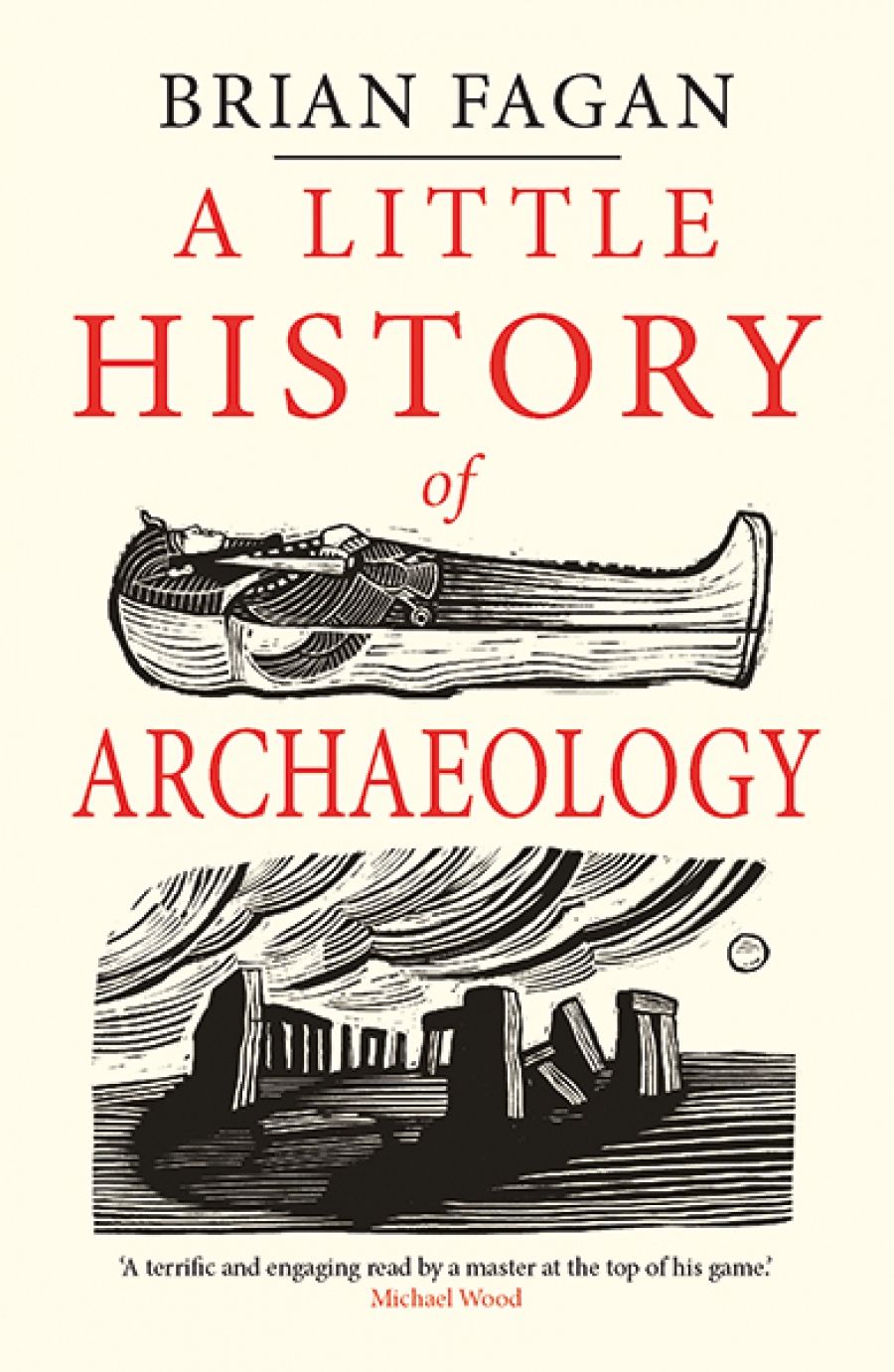
- Free Article: No
- Contents Category: History
- Custom Article Title: Kelly D. Wiltshire reviews <em>A Little History of Archaeology</em> by Brian Fagan
- Custom Highlight Text:
As the old saying goes, one should never judge a book by its cover; however, the instantly recognisable iconography on the cover of A Little History of Archaeology does provide an insight into this book’s content ...
- Book 1 Title: A Little History of Archaeology
- Book 1 Biblio: Yale University Press (Footprint), $37.99 hb, 288 pp, 9780300243215
Fagan also describes investigations by early Egyptologist Flinders Petrie, whose protégé Howard Carter was a key figure in the discovery of Tutankhamun’s tomb in 1922 – an event that received international media attention and popularised archaeology with the general public. It comes as no surprise that this event is used to preface the second half of the book, which charts the growth of global archaeology during the nineteenth century. Here we are introduced to the work of the first Australian-born archaeologist, Vere Gordon Childe, and his contemporary Mortimer Wheeler, dendrochronology and its study of tree rings to determine past climatic change, the advent of radiocarbon dating in the 1950s that revolutionised archaeology by allowing sites to be placed within a chronological context, the discovery of China’s terracotta warriors, the development of underwater archaeology in the survey and excavation of shipwrecks, and the discovery of Ötzi the Ice Man in the Alps between Italy and Austria.
 Naturalistic reconstruction of Ötzi the Ice Man using forensic methods, exhibited in the South Tyrol Museum of Archeology in Bolzano, Italy (photograph by Thilo Parg/Wikimedia Commons)In these chapters, the work of Gertrude Bell and Harriet Boyd is presented in a single chapter – a curious choice considering Fagan’s belief that these woman ‘were the equals of any male archaeologists of their day’. This is particularly surprising considering that Boyd’s work in Crete was carried out alongside the investigations of Arthur Evans, whose work is presented in an earlier chapter. As a result, this chapter instead feels tokenistic in its effort to highlight the trowel-blazing work of these women.
Naturalistic reconstruction of Ötzi the Ice Man using forensic methods, exhibited in the South Tyrol Museum of Archeology in Bolzano, Italy (photograph by Thilo Parg/Wikimedia Commons)In these chapters, the work of Gertrude Bell and Harriet Boyd is presented in a single chapter – a curious choice considering Fagan’s belief that these woman ‘were the equals of any male archaeologists of their day’. This is particularly surprising considering that Boyd’s work in Crete was carried out alongside the investigations of Arthur Evans, whose work is presented in an earlier chapter. As a result, this chapter instead feels tokenistic in its effort to highlight the trowel-blazing work of these women.
Fagan, however, does redeem himself slightly by highlighting how Gertrude Caton-Thompson’s investigations at Zimbabwe’s Great Enclosure challenged racist myths that were used to justify African dispossession. Mary Leakey’s excavations at Olduvai Gorge in northern Tanzania – which revealed a hominin crania, pushing back the age of human origins – are also highlighted. The same considerations cannot be said for Tessa Wheeler – wife of Mortimer Wheeler – whose contribution fades into the background of her husband’s achievements, despite the fact that they worked together on numerous excavations as a team.
The influence of Cambridge archaeologist Grahame Clark in the development of archaeology beyond Europe, by encouraging his students to work overseas, is also discussed. Fagan was one of these students and subsequently went on to work in Africa. Another of Clark’s students was Rhys Jones, who came to Australia and later become well known for his archaeological investigations in Tasmania, Neither Jones nor Australian archaeology more broadly rates a mention in this book. This is an unfortunate omission, especially considering the number of internationally significant sites found on our shores, including the World Heritage area of Lake Mungo, the highly sophisticated aquaculture structures at Lake Condah, and Kutikina Cave in Tasmania, which was once described by Jones ‘as rich as the richest classic caves of France’. Readers disappointed by this oversight should consult Billy Griffiths’s Deep Time Dreaming: Uncovering ancient Australia (2018), which provides a colourful history of Australian archaeology. Deep Time Dreaming contrasts greatly with Fagan’s controlled and at times disjointed descriptions – a likely side effect of trying to cover a disciplinary history spanning 250 years within the confines of 277 pages.
A Little History of Archaeology concludes by focusing on how present-day technologies are being applied to the well-known sites of Stonehenge and Angkor Wat. In the final chapter, archaeological investigations for London’s Crossrail Project, which recently unearthed the grave of Matthew Flinders, also rate a mention, ensuring that the conclusion of this history of archaeology – notwithstanding some omissions – does reflect aspects of contemporary archaeology beyond the misconceptions that continue to plague the discipline.


Comments powered by CComment